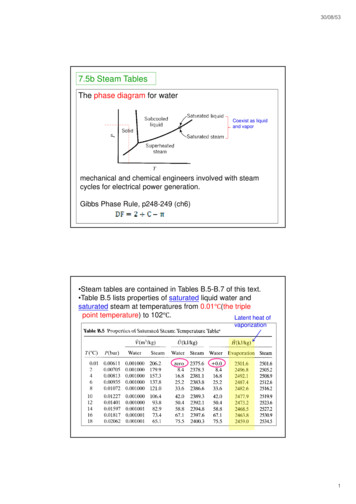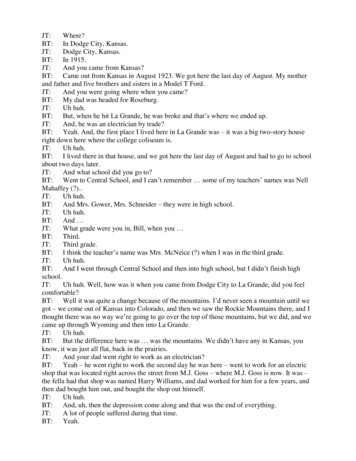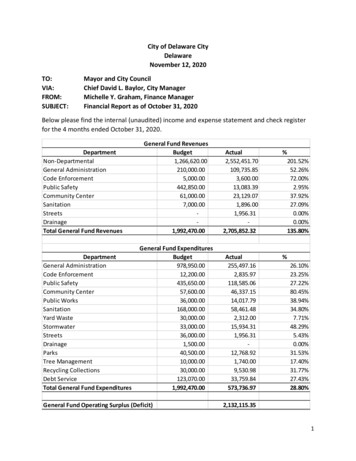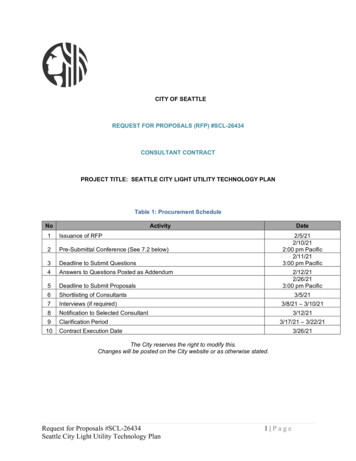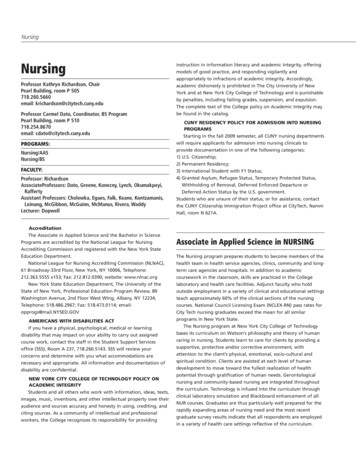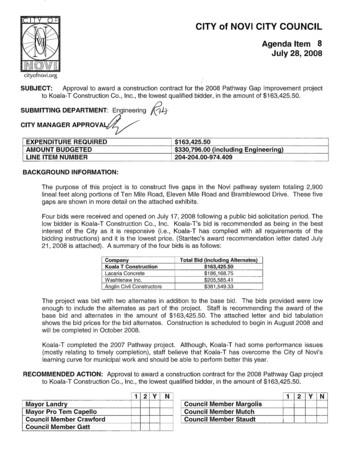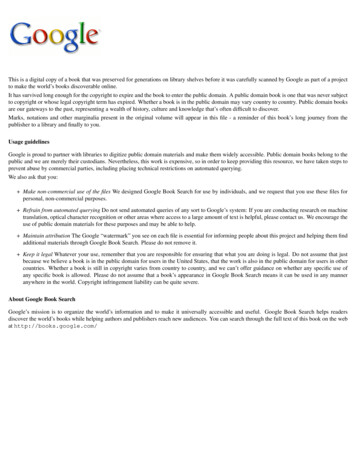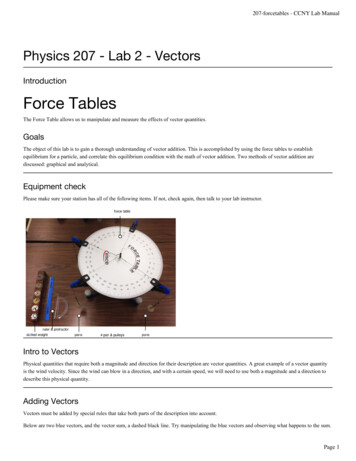
Transcription
207-forcetables - CCNY Lab ManualPhysics 207 - Lab 2 - VectorsIntroductionForce TablesThe Force Table allows us to manipulate and measure the effects of vector quantities.GoalsThe object of this lab is to gain a thorough understanding of vector addition. This is accomplished by using the force tables to establishequilibrium for a particle, and correlate this equilibrium condition with the math of vector addition. Two methods of vector addition arediscussed: graphical and analytical.Equipment checkPlease make sure your station has all of the following items. If not, check again, then talk to your lab instructor.Intro to VectorsPhysical quantities that require both a magnitude and direction for their description are vector quantities. A great example of a vector quantityis the wind velocity. Since the wind can blow in a direction, and with a certain speed, we will need to use both a magnitude and a direction todescribe this physical quantity.Adding VectorsVectors must be added by special rules that take both parts of the description into account.Below are two blue vectors, and the vector sum, a dashed black line. Try manipulating the blue vectors and observing what happens to the sum.Page 1
207-forcetables - CCNY Lab ManualAbout the Force TableLet's understand exactly how the force table works. A mass is placed in each pan (each pan has a mass of 50g). This mass experiences a forcedue to gravity given by its mass times g . This force is acting in the vertical direction. In order to redirect the force to act in a horizontaldirection (i.e parallel to the surface of the table), chords and pulleys are used. Thus, the tensions from the chords on the ring at the center areequal in magnitude to the force due to gravity on the pan mass:T1 m1 gAttaching several pan/pulley systems to the table allows us to pull on the ring with different tensions in different directions.What will the tension be, in Newtons, if a 20 gram mass is attached to the 50g tray?Tension [N] Instructions for use:1. The central ring has spokes that connect the inner and outer edges. When connecting the cords be sure that the hooks have not snaggedon a spoke. In that case the cord will not be radial. Also whenever you change a pulley position, check that the cord is still radial.2. Be sure that when you position a pulley, that both edges of the clamp arc snugly against the edge of the force table. Check that the cordis on the pulley.3. There are two tests for equilibrium.A. The first test is to move the pin up and down and observe the ring. If it moves with the pin, the system is NOT in equilibriumand forces need to be adjusted.B. The second test is to remove the pin. However, this should be done in two stages. First just lift it but hold it in the ring toprevent large motions. If there is no motion, remove it completely. If the ring remains centered then the system is inequilibrium.Page 2
207-forcetables - CCNY Lab ManualExp. 1: Sensitivity of the instrumentLet's measure how precise the force tables are.1.2.3.4.Arrange two pulley systems, Pan 1 at 0 and Pan 2 at 180 .In Pan 1, place 50 grams. In Pan 2, also place 50 grams.Now, in Pan 2 add 1 gram and check for equilibrium. It's most likely still in equilibrium, right?Find the maximum mass you can place in pan 2 and still maintain experimental equilibrium.Record this value below. This is the sensitivity to weight of the force table.Sensitivity [g] Report Question 1What factors could contribute to this sensitivity?Resultant Vs. EquilibrantA point to be aware of is that the force needed to balance the system is not the resultant of the weights, but the negative of that vector, alsocalled the equilibrant.Response:Page 3
207-forcetables - CCNY Lab ManualIf the resultant of 2 mass/tray systems points in a direction 234 measured counter-clock-wise (CCW) from the 0 line, in what direction shouldthe equilibrant point?Direction of Equilibrant [ ] Experiment 2: Symmetric Arrangement1. Using the number generator below, pick two initial masses and directions.Generate NumbersMass 1: x gramsDirection 1: x Mass 2: x gramsDirection 2: x 2. Set up two pans and mass systems based on these values.3. Experimentally balance the system. (i.e. without performing any math or analytical operations, find a third pan/mass system that willbalance the first two.)Mass needed to balance the System [g] Use the simulated force table below to predict how much mass you should need and compare this to the value you found experimentally. Makesure to include the mass of the pans in when setting up the forces. (You can use g 10m/s2 for this)By how many grams was your experiment different from this simulation?Grams difference Report Question 2Report the difference between what you've experimentally measured and what the simulation predicted. Are they within the expectedsensitivity of the instrument?Exp. 3: Find a functionSet up the table at shown. Place 50 grams in pans 1 and 2. Make both angles b equal to 5 degrees.1. Experimentally determine the mass needed to hang from pan 3 to put the system into equilibrium2. Repeat the measurement, changing the angles b each time, in 5 increments, until you reach 80 . (Change the positions of both Pans 1Page 4
207-forcetables - CCNY Lab Manualand 2 each time)3. Compile the results in a table like this.AngleMass of Pan 3 system5 P3 mass10 P3 mass 80 P3 massWe would expect there to be some mathematical relation between the angle b, the mass of P1 and P2 , and the mass of P3 needed to balance thesystem. Using some basic trigonometry, determine an equation that we can use to predict the mass of P3 as a function of the angle b, and themass of P1 P2 (considered a constant equal to 200g). It should be something of the form P3 C cos(b), where C is a constant.In the box below, enter the formula you have found that will predict the mass of Pan 3.Formula: Report Question 3On one graph plot the experimental data from your table along with the analytical prediction of the function you found. Do they follow thesame trend?Your plots should like a section of a cosine function. We can make the data a little easier to work with by plotting the mass as function ofthe cos(b) instead. Plot the results (both experimental and anlytical) with the mass of P3 on the vertical axis, and the cos(b) on thehorizontal axis. This should be a linear line:if h(x) cos(x) and f(x) C cos(x) f(x) C h(x) a linear functionFind the slope of your linear data and compare it to what the slope should be from your analytical equation. Does it differ from theanalytically derived slope by less than the uncertainty? There are more details about this process here (curve-fitting.php).Vector ComponentsOur mathematical framework for dealing with multiple vectors involves using vector components. If we have an x-y coordinate axis, any vectoron this axis can be decomposed into its x and y components. The simulation below shows one vector decomposed into its x and y components.Q: Components What angle (measured counterclockwise from the x axis) would a vector A need to have so that the magnitude of the x component was equalto twice the magnitude of the y component?angle forAx 2 Ay What angle (measured counterclockwise from the x axis) would a vector A need to have so that the magnitude of the y component was equalto half the magnitude of the original vector?angle fory 0.5 A Page 5
Ay 0.5 A 207-forcetables - CCNY Lab ManualWe'll need vector components to do more complicated calculations as the next section shows.Multiple ForcesExp. 4: Return to the Force TableNow let's apply these concepts to the force table. If we have 3 known forces acting, we should be able to analytically predict a fourth force toadd so that the system is in equilibrium, i.e. Fnet 0.Press the blue button below to generate 3 sets of random masses and directionsGenerate Numbers Vector AMass 1: x gramsDirection 1: x Vector BMass 2: x gramsDirection 2: x Vector CMass 3: x gramsDirection 3: x Now, use component algebra to calculate a forth vector, D , that when added to the system will result in equilibrium The Equation you are essentially trying to solve is: A B C D 0Once you have arrived an answer, enter the components of the vector in the boxes below Dx Dy Use trig to convert your answer back to a magnitude and degree format. Add all four mass/pan systems (3 from the above, the fourth from yourprediction) to the table, and verify that the prediction does indeed balance the system.Report Question 4Give the details of this calculation and compare your analytical results with the the experimental results.Draw a vector diagram that shows the table arrangement.Page 6
Let's understand exactly how the force table works. A mass is placed in each pan (each pan has a mass of 50g). This mass experiences a force due to gravity given by its mass times . This force is acting in the vertical direction. In order to redirect the force to act in a horizontal direction (i.e parallel to the surface of the table), chords and pulleys are used. Thus, the tensions from the chords on the ring at the center are
